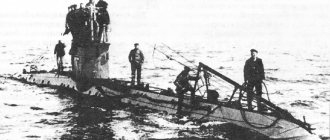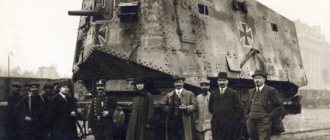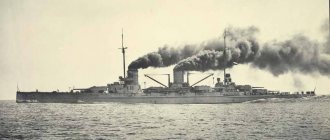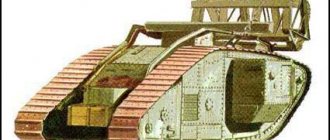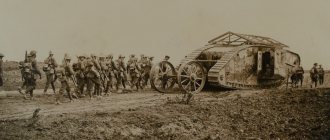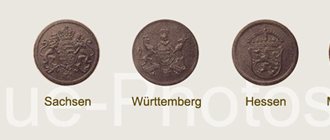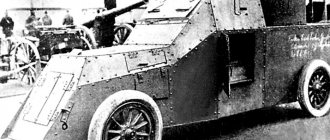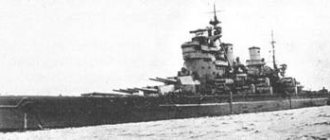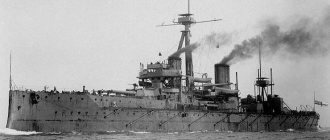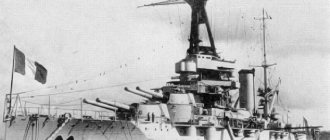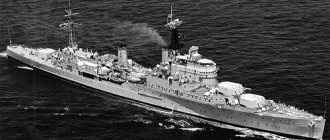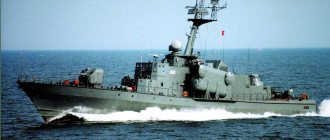War is the most terrible time in the history of mankind, but during it, paradoxically, there is technological progress that helps maintain life in peacetime. Today we will talk about the different types of battleships that participated in the First World War.
Many states took part in the Great War. It caused a large number of victims around the world. Human ingenuity knew no bounds in the creation of military equipment. Warships became part of these inventions. Naval battles were an integral and important aspect of the First World War. They led countries to quick victories.
Many great battleships took part in the Great War. A large number of them were lost during the battles, while others were modernized and improved. They were ships from different countries, Japan, Germany, Great Britain, but not all of them will participate in our list.
Ammiraglio di San Bon
This ship was built in Italy in the 1890s. He managed to lead the Italian fleet to several important victories in the Italo-Turkish War. She had a volume of 10,700 tons, a length of 367 feet, a beam of 69 feet, and a draft of 25 feet. It could accommodate 500 naval officers.
Its speed reached 18 knots. This battleship performed well during naval battles. It had enough space to accommodate an arsenal. A large number of sets of guns were located at the bow and stern of the battleship. Its design had enough space to accommodate torpedo tubes, which would destroy enemy ships below the waterline.
Light cruisers
Light cruisers of the Kolberg type - 4 pcs.
An analysis of the state of the fleets after the appearance of the Dreadnought revealed another weak point: the British, even on the scouts of the Forward series, began to use a light armor belt. And the experience of the RYAV (what is it - Yalu!) showed how significant the armor belt is. An experimental shooting of excluded old ships was also carried out with 10.5 cm guns from the cruiser Bremen and 15 cm guns from the cruiser Victoria Louise. The result was clear - no rate of fire could help five 10.5 cm guns overcome the power of 15 cm shells, even with a smaller number of barrels. And the experience of the RYAV suggested that 6″ guns were quite suitable for firing at destroyers. In this regard, it was decided to switch light cruisers to 150 cm caliber. Here the problem of weight arose, but it was relevant only for guns standing on the sides, because at the extremities one could simply replace the pair of 10.5 cm with a single 15 cm. Which, by the way, was decided to be done with the previously built cruisers, starting with those under construction, bringing their armament to 2*15 cm + 6*10.5 cm.
But the new ships needed a uniform 15 cm caliber.
All these considerations led to the appearance of a fundamentally new ship. The ram-shaped stem was abandoned; the poop was cut off to save weight and reduce the affected area.
The armament consisted of 5*15 cm guns, located according to the “Dreadnought” scheme. We had to put up with one unused gun for the sake of fire at sharp heading angles necessary for a cruiser. Just in case, we decided to leave 4*8.8 cm guns for firing at small targets (later replaced by anti-aircraft guns). Such a modest number of guns was explained by economy and reasonable sufficiency - but, in addition, it was the small number of 15 cm guns that ensured the minimization of the reaction of the English fleet.
Displacement: 4400 tons.
CMU power: 19,000 – 20,200t, speed 25.5-26.5 knots.
Armament: 5*15 cm, 4*8.8 cm, 2 TA 500mm
Reservation: belt 60 mm, deck up to 40 mm, deckhouse 100 mm.
Light cruisers of the Magdeburg type - 4 pcs.
Almost a complete repetition of the previous type, with speed increased to 27-27.5 knots and minor improvements in armor (armor area in the bow, tower-like gun shields instead of traditional ones at the cost of reducing their thickness).
Light cruisers of the Karlsruhe type - 2 pcs.
Almost a complete repetition of the previous type, with speed increased to 28 knots.
Light cruisers of the Graudenz type - 2 pcs.
The previous series was shortened due to the decision to take the next step in armament. A sixth 15 cm gun was added at the stern, single underwater torpedo tubes were replaced by triple rotating ones on the deck, covered with light anti-fragmentation casings. True, the speed due to the weight of the weapons decreased to 27.5 st.
Light cruisers of the Wiesbaden type - 4 pcs.
Development of the previous type with an increase in speed to 28 knots. The displacement reached 5000 tons.
Light cruisers of the Nuremberg class
In connection with the British response - type C cruisers with uniform 152 mm guns - it was decided to continue the course towards qualitative superiority. Now the armament has been strengthened to 7*15 cm guns (6 on board, at least 3 at any point on the horizon, due to the linearly elevated arrangement of the guns at the extremities). The armor area was also increased, the displacement was 5,600 tons. They entered service already during the war; 10 cruisers were laid down according to the military program.
HMS Barham
Barham was built in Great Britain in the 1910s. This battleship had a glorious legendary history. It was created to deprive the Germans of superiority at sea and increase British victories in naval battles. This ship is a famous veteran of the First World War. The vessel belongs to the Queen Elizabeth class. There were a total of six such analogues. Having more than 24 boilers, the battleship was one of the fastest and most maneuverable ships of the First World War.
Its speed reached 24 knots. Barham was equipped with several guns and a special two-gun turret. The battleship posed a huge threat to the enemy. It could accommodate a crew of 1,000 people. When torpedoes were placed on it, the ship proved its importance in the famous Battle of Jutland.
Benedetto Brin
This battleship was built by the Italians in 1899 - 1905.
Its service life was short. Benedetto Breen was one of the first to enter the First World War.
It belonged to the Regina Margherita class of warships.
It was created for military conflicts on open water.
His advantage was speed, not defense.
The battleship was well equipped with weapons, this compensated for the lack of protection. Benedetto Brin was a formidable opponent in the sea.
The ship was lost in an explosion that occurred on board while stationed in Tripoli.
There is a version that this was a consequence of sabotage and sabotage.
Caio Duilio
This is another Italian battleship of the Andrea Doria class. It was built in 1912. Caio Duilio managed to survive not only two world wars, but also the Cold War. Thanks to the capabilities of the dreadnought class, it would be able to withstand many conflicts. It housed five turrets and 1,500 crew on board. The battleship was on patrol. The enemy was afraid to come close to it, so the ship did not participate in the hostilities. But its role for the Italians was great, since the battleship served as excellent protection for the Italian fleet.
Sea alert
Alfred von Tirpitz
The second military mind of Kaiser Germany after his namesake Schlieffen. If he was more interested in France, then Tirpitz challenged Britain's naval dominance.
The ships of the German school were different from the British ones. “Mistress of the Seas” built its battleships for generalized combat in any available theater (which immediately set the requirements for autonomy and range). On the other side of the strait, Alfred von Tirpitz created a “counter-British” fleet, adjusted for the need for preferential action on its shores - in the poor visibility conditions characteristic of the North Sea.
As a result, the German fleet regularly received ships with a short range, formally weaker artillery (by generation: 280 millimeters versus 305; 305 millimeters versus 343), but much better protected. The advantage of the heavier British guns at short ranges was partially offset by the flat trajectory and speed of the lighter German shells.
Germany responds to Fischer with a series of four Nassau-class battleships (21 thousand tons, 20 knots, 12x280 in six towers, main belt 270-290 millimeters), commissioned in 1909-1910. In 1911-1912, the Kaiserlichmarine received a series of four Heligolands (24.7 thousand tons, 20.5 knots, 12x280 in six towers, main belt 300 millimeters).
In the same period (1909-1912), the Germans also built three battlecruisers: the non-serial "Von der Tann" (21 thousand tons, 27 knots, 8x280 in four towers, main belt 250 millimeters) and the same type "Moltke" with " Goeben" (25.4 thousand tons, 28 knots, 10x280 in five towers, main belt 280 millimeters).
The school's approach is clear from the characteristics of Invincible's German rivals. The “grosserkreuzers” had a different tactical niche - they were immediately created with the expectation of participating in linear combat, hence greater security and increased attention to survivability. Again, the misadventures of the Seydlitz, mutilated in Jutland, which hobbled to the base in a half-submerged state, speak for themselves: in fact, they were not so much cruisers as the forerunners of a new class of high-speed battleships.
Image of Nassau, the first of the Kaiser's dreadnoughts
Photo:
Britain was not left out. Having received information about the German program of 1908, the British press went into hysterics with the slogan “We want eight and we won’t wait.” As part of this “sea alarm”, some ships with 305-mm guns from the list given above were laid down.
However, the designers looked ahead. The emergency shipbuilding program of 1909 provided for the development of “super-dreadnoughts”—battleships with a 343-mm main gun. It was this “hardware” that became the basis of the British battle fleet in the First World War: four “Orions” and four “King George V” (26 thousand tons, 21 knots, 10x343 in five towers, main belt 305 millimeters) and four “Iron” Duke" (30 thousand tons, 21 knots, 10x343, main belt 305 millimeters) - all of them were put into operation from 1912 to 1914.
The second generation of battlecruisers, introduced between 1912 and 1914, was represented by two ships of the Lion class, one of the Queen Mary class (31 thousand tons, 28 knots, 8x343 in four turrets, main belt 229 mm) and one of the "Tiger" (34 thousand tons, 28 knots, 8x343 in four towers, main belt 229 millimeters). The series received the unofficial nickname Splendid Cats (“Magnificent Cats”), which, given the times and morals, smacked of some obscenity, because the two cruisers were called “Princess Royal” and “Queen Mary”.
Battlecruiser "Tiger" (UK)
Photo:
The Germans responded to this by switching to a caliber of 305 millimeters. In 1912-1913, five Kaiser-class dreadnoughts appeared (27 thousand tons, 21 knots, 10x305 in five towers, main belt 350 millimeters), in 1914 - four König types (29 thousand tons, 21 knots, 10x305 in five towers, main belt 350 millimeters). In 1913, the transitional battle cruiser Seydlitz with 280 millimeters was completed, and then a series of three new ships of the Derflinger type began (31 thousand tons, 26 knots, 8x305 in four towers, main belt 300 millimeters).
F. J. Bouvet
This battleship belonged to the French fleet. It was built in 1912. He became a star of the French navy, playing a decisive role in the First World War. But his fate is sad. During the battle, the ship sank near the Dardanelles in March 1915. F. J. Bouvet was one of the main frontier battleships during the First World War. The French were very proud of him. She was then demoted to dreadnought. Still, it was quite formidable with a strong bridge superstructure and twin masts. It featured low profile and single gun masts at the bow and stern. The battleship took part in the war against the Turks, but was sunk by mines.
Navies of the leading powers at the beginning of the First World War
Before the outbreak of the First World War, the great powers paid great attention to their naval forces, and large-scale naval programs were being implemented. Therefore, when the war began, the leading countries had numerous and powerful fleets. Particularly persistent competition in building up naval power was between Great Britain and Germany. The British at that time had the most powerful navy and merchant fleet, which made it possible to control strategic communications in the World Ocean and link together numerous colonies and dominions. In 1897, the German Navy was significantly inferior to the British Navy. The British had 57 battleships of I, II, III, classes, the Germans 14 (4:1 ratio), the British 15 coastal defense battleships, the Germans 8, the British 18 armored cruisers, the Germans 4 (4.5:1 ratio ), the British have 125 cruisers of 1-3 classes, the Germans have 32 (4:1), the Germans were also inferior in other combat units.
Arms race
The British wanted not only to maintain their advantage, but also to increase it. In 1889, parliament passed a law that allocated more funds for the development of the fleet. London's naval policy was based on the principle that the British Navy should be superior to the two navies of the most powerful naval powers.
Berlin initially did not pay much attention to the development of the fleet and the seizure of colonies; Chancellor Bismarck did not see much sense in this, believing that the main efforts should be directed to European politics and the development of the army. But under Emperor Wilhelm II, priorities were revised, Germany began to fight for colonies and build a powerful fleet. In March 1898, the Reichstag adopted the “Fleet Law,” which provided for a sharp increase in the Navy. Over the course of 6 years (1898-1903), they planned to build 11 squadron battleships, 5 armored cruisers, 17 armored cruisers and 63 destroyers. Germany's shipbuilding programs were subsequently constantly adjusted upward - in 1900, 1906, 1908, 1912. According to the law of 1912, the size of the fleet was planned to be increased to 41 battleships, 20 armored cruisers, 40 light cruisers, 144 destroyers, 72 submarines. Particularly great attention was paid to battleships: in the period from 1908 to 1912, 4 battleships were laid down in Germany annually (in previous years, two).
London believed that Germany's naval efforts posed a great threat to Britain's strategic interests. England intensified the naval arms race. The task was set to have 60% more battleships than the Germans. Since 1905, the British began building a new type of battleship - “dreadnoughts” (after the name of the first ship of this class). They differed from squadron battleships in that they had stronger weapons, were better armored, had a more powerful power plant, greater displacement, etc.
Battleship Dreadnought.
Germany responded by building its own dreadnoughts. Already in 1908, the British had 8 dreadnoughts, and the Germans had 7 (some were in the process of completion). The ratio for “pre-dreadnoughts” (squadron battleships) was in favor of Britain: 51 against 24 German ones. In 1909, London decided to build two of its own for every German dreadnought.
The British tried to maintain their naval power through diplomacy. At the Hague Peace Conference in 1907, they proposed limiting the scale of construction of new warships. But the Germans, believing that this step would only benefit Britain, rejected this proposal. The naval arms race between England and Germany continued until the First World War. By its beginning, Germany had firmly taken the position of the second military naval power, overtaking Russia and France.
Other great powers - France, Russia, Italy, Austria-Hungary, etc., also tried to build up their naval armaments, but due to a number of reasons, including financial problems, they were unable to achieve such impressive successes.
Queen Elizabeth is the lead ship of the Queen Elizabeth series of super-dreadnoughts.
The meaning of fleets
The fleets were required to perform a number of important tasks. Firstly, to protect the coasts of countries, their ports, important cities (for example, the main purpose of the Russian Baltic Fleet is to protect St. Petersburg). Secondly, the fight against enemy naval forces, supporting one's ground forces from the sea. Thirdly, the protection of sea communications, strategically important points, especially for Britain and France, they owned huge colonial empires. Fourthly, to ensure the status of the country, a powerful navy showed the position of the power in the world informal table of ranks.
The basis of the then naval strategy and tactics was linear combat. In theory, the two fleets were supposed to line up and find out who the winner was in an artillery duel. Therefore, the basis of the fleet was squadron battleships and armored cruisers, and then dreadnoughts (from 1912-1913 and super-dreadnoughts) and battlecruisers. Battlecruisers had weaker armor and artillery, but were faster and had a greater range. Squadron battleships (pre-dreadnought battleships) and armored cruisers were not written off, but they were relegated to the background, ceasing to be the main striking force. Light cruisers were supposed to carry out raids on enemy sea communications. Destroyers and torpedo boats were intended for torpedo strikes and destruction of enemy transports. Their combat survivability was based on speed, agility and stealth. The Navy also included special-purpose ships: minelayers (they installed sea mines), minesweepers (they made passages in minefields), transports for seaplanes (hydrocruisers), etc. The role of the submarine fleet was constantly growing.
Battlecruiser Goeben
Great Britain
The British at the beginning of the war had 20 dreadnoughts, 9 battle cruisers, 45 old battleships, 25 armored and 83 light cruisers, 289 destroyers and torpedo boats, 76 submarines (most of them were obsolete, they could not operate on the high seas). It must be said that, despite all the power of the British fleet, its leadership was distinguished by great conservatism. New products had difficulty finding their way (especially those not related to the linear fleet). Vice Admiral Philippe Colomb, a naval theorist and historian, author of the book “Naval Warfare, Its Basic Principles and Experience” (1891), said: “There is nothing that would show that the laws long established by the history of naval warfare are somehow or have changed in some way." The admiral substantiated the theory of "mastery of the sea" as the basis of Britain's imperial policy. He believed that the only way to achieve victory in a war at sea was to create complete superiority in naval forces and destroy the enemy Navy in one general battle.
When Admiral Percy Scott suggested that “the era of dreadnoughts and super-dreadnoughts is over forever” and advised the Admiralty to concentrate its efforts on the development of aviation and the submarine fleet, his innovative ideas were sharply criticized.
The general management of the fleet was carried out by the Admiralty, headed by W. Churchill and the First Sea Lord (chief of the main naval staff) Prince Ludwig Battenberg. British ships were based in the harbors of Humberg, Scarborough, Firth of Forth and Scapa Flow. In 1904, the Admiralty considered the issue of relocating the main forces of the Navy from the English Channel north to Scotland. This decision removed the fleet from the threat of a blockade of the narrow strait by the growing German Navy, and made it possible to quickly control the entire North Sea. According to the English naval doctrine, which was developed shortly before the war by Battenberg and Bridgeman, the basing of the main forces of the fleet in Scapa Flow (a harbor in Scotland on the Orkney Islands), outside the effective radius of the German submarine fleet, was supposed to lead to a blockade of the main forces of the German fleet, which and happened during the First World War.
When the war began, the British were in no hurry to approach the German shores, fearing attacks from submarines and destroyer forces. The main fighting took place on land. The British limited themselves to covering communications, protecting the coast and blockading Germany from the sea. The British fleet was ready to enter the battle if the Germans took their main fleet to the open sea.
British "Great Fleet".
Germany
The German Navy had 15 dreadnoughts, 4 battle cruisers, 22 old battleships, 7 armored and 43 light cruisers, 219 destroyers and torpedo boats, and 28 submarines. According to a number of indicators, for example, in speed, German ships were better than British ones. Much more attention was paid to technical innovations in Germany than in England. Berlin did not have time to complete its naval program, which was supposed to end in 1917. Although the German naval leaders were quite conservative, Admiral Tirpitz initially believed that getting involved in the construction of submarines was “frivolous.” And supremacy at sea is determined by the number of battleships. Only after realizing that the war would begin before the completion of the battle fleet construction program did he become a supporter of unlimited submarine warfare and the accelerated development of the submarine fleet.
The German "High Sea Fleet" (German: Hochseeflotte), based in Wilhelmshaven, was supposed to destroy the main forces of the British fleet ("Grand Fleet" - "Big Fleet") in an open battle. In addition, there were naval bases in Kiel, about. Helgoland, Danzig. The Russian and French Navy were not perceived as worthy opponents. The German "High Seas Fleet" posed a constant threat to Britain and forced the British Grand Fleet to remain constantly in the North Sea at full combat readiness throughout the war, despite the shortage of battleships in other theaters of war. Due to the fact that the Germans were inferior in the number of battleships, the German Navy tried to avoid open clashes with the Grand Fleet and preferred a strategy of raids into the North Sea, trying to lure out part of the British fleet, cut it off from the main forces and destroy it. In addition, the Germans concentrated their attention on waging unrestricted submarine warfare to weaken the British Navy and lift the naval blockade.
The combat effectiveness of the German Navy was affected by the lack of autocracy. The main creator of the fleet was Grand Admiral Alfred von Tirpitz (1849 – 1930). He was the author of the "risk theory", which stated that if the German fleet was comparable to the English in strength, then the British would avoid conflicts with the German Empire, because in the event of war, the German Navy would have a chance to inflict sufficient damage on the Grand Fleet for the British fleet to lose supremacy at sea. With the outbreak of the war, the role of the grand admiral declined. Tirpitz became responsible for the construction of new ships and the supply of the fleet. The High Seas Fleet was led by Admiral Friedrich von Ingenohl (1913-1915), then Hugo von Pohl (from February 1915 to January 1916, before that he was Chief of the General Naval Staff), Reinhard Scheer (1916-1918). In addition, the fleet was the favorite brainchild of the German Emperor Wilhelm; while he trusted the generals to make decisions about the army, the Navy was managed by himself. Wilhelm did not dare to risk the fleet in an open battle and allowed only a “small war” to be waged - with the help of submarines, destroyers, and mine laying. The battle fleet had to adhere to a defensive strategy.
German "High Seas Fleet"
France. Austria-Hungary
The French had 3 dreadnoughts, 20 battleships of the old type (battleships), 18 armored and 6 light cruisers, 98 destroyers, 38 submarines. In Paris they decided to focus on the “Mediterranean Front”, fortunately the British agreed to defend the Atlantic coast of France. Thus, the French saved expensive ships, because there was no great threat in the Mediterranean Sea - the Ottoman Navy was very weak and tied up by the Russian Black Sea Fleet, Italy was at first neutral and then went over to the Entente side, the Austro-Hungarian fleet chose passive strategy. In addition, there was a fairly strong British squadron in the Mediterranean.
The Austro-Hungarian Empire had 3 dreadnoughts (the 4th entered service in 1915), 9 battleships, 2 armored and 10 light cruisers, 69 destroyers and 9 submarines. Vienna also chose a passive strategy and “defended the Adriatic”; the Austro-Hungarian fleet remained in Trieste, Split, and Pula for almost the entire war.
"Tegetthof" in the pre-war years. Austro-Hungarian battleship of the Viribus Unitis type.
Russia
The Russian fleet under Emperor Alexander III was second only to the navies of England and France, but then lost this position. The Russian Navy received a particularly big blow during the Russo-Japanese War: almost the entire Pacific squadron and the best ships of the Baltic Fleet, sent to the Far East, were lost. The fleet needed to be restored. Several naval programs were developed between 1905 and 1914. They provided for the completion of 4 previously laid down squadron battleships, 4 armored cruisers and the construction of 8 new battleships, 4 battleships and 10 light cruisers, 67 destroyers and 36 submarines. But by the beginning of the war, not a single program had been fully implemented (the State Duma also played a role in this, which did not support these projects).
By the beginning of the war, Russia had 9 old battleships, 8 armored and 14 light cruisers, 115 destroyers and destroyers, 28 submarines (a significant part of the old types). Already during the war, the following were put into operation in the Baltic - 4 dreadnoughts of the Sevastopol type, all of them were laid down in 1909 - Sevastopol, Poltava, Petropavlovsk, Gangut; on the Black Sea - 3 dreadnoughts of the "Empress Maria" type (laid down in 1911).
"Poltava" during the First World War.
The Russian Empire was not a backward power in the naval field. It even took the lead in a number of areas. Russia has developed excellent Novik-class destroyers. By the beginning of the First World War, the ship was the best destroyer in its class, and served as a world model for the creation of destroyers of the war and post-war generation. The technical conditions for it were created by the Marine Technical Committee under the leadership of outstanding Russian shipbuilding scientists A. N. Krylov, I. G. Bubnov and G. F. Shlesinger. The project was developed in 1908-1909 by the shipbuilding department of the Putilov plant, which was headed by engineers D. D. Dubitsky (mechanical part) and B. O. Vasilevsky (shipbuilding part). At Russian shipyards, in 1911-1916, in 6 standard projects, a total of 53 ships of this class were laid down. The destroyers combined the qualities of a destroyer and a light cruiser - speed, maneuverability and fairly strong artillery weapons (4th 102 mm guns).
Russian railway engineer Mikhail Petrovich Nalyotov was the first to realize the idea of a submarine with anchor mines. Already in 1904, during the Russo-Japanese War, participating in the heroic defense of Port Arthur, Nalyotov, at his own expense, built a submarine with a displacement of 25 tons, capable of carrying four mines. Conducted the first tests, but after the surrender of the fortress the device was destroyed. In 1909-1912, a submarine called “Crab” was built at the Nikolaev shipyard. She became part of the Black Sea Fleet. During the First World War, the "Crab" made several combat missions with mine laying, even reaching the Bosporus.
The world's first underwater minelayer - the submarine "Crab" (Russia, 1912).
Already during the war, Russia became a world leader in the use of hydrocruisers (aircraft carriers), fortunately, this was facilitated by the factor of dominance in the creation and use of naval aviation. Russian aircraft designer Dmitry Pavlovich Grigorovich, since 1912 he worked as the technical director of the plant of the First Russian Aeronautics Society, in 1913 he designed the world's first seaplane (M-1) and immediately began to improve the aircraft. In 1914, Grigorovich built the M-5 flying boat. It was a two-seat biplane of wooden construction. The seaplane entered service with the Russian fleet as a reconnaissance aircraft and artillery fire spotter, and in the spring of 1915 the aircraft made its first combat mission. In 1916, Grigorovich's new aircraft, the heavier M-9 (naval bomber), was put into service. Then the Russian genius designed the world's first fighter seaplane, the M-11.
For the first time, Russian dreadnoughts of the Sevastopol type used a system for installing not two, but three-gun turrets of the main caliber. In England and Germany, they were initially skeptical about the idea, but the Americans appreciated the idea and Nevada-class battleships were built with three-gun turrets.
In 1912, 4 Izmail-class battlecruisers were laid down. They were intended for the Baltic Fleet. These would be the most powerful battlecruisers in the world in terms of artillery armament. Unfortunately, they were never completed. In 1913-1914, eight light cruisers of the Svetlana class were laid down, four each for the Baltic and Black Sea fleets. They were going to be put into operation in 1915-1916, but did not have time. Russian Bars-class submarines were considered one of the best in the world (they began to be built in 1912). A total of 24 Bars were built: 18 for the Baltic Fleet and 6 for the Black Sea.
It should be noted that the Western European fleets in the pre-war years paid little attention to the submarine fleet. This is due to two main reasons. Firstly, previous wars had not yet revealed their combat significance; only in the First World War did their enormous significance become clear. Secondly, the then dominant naval doctrine of the “high seas” assigned submarine forces one of the last places in the struggle for the sea. Dominance in the seas was to be won by battleships, having won a decisive battle.
Russian engineers and artillery sailors made a great contribution to the development of artillery weapons. Before the start of the war, Russian factories began producing improved models of naval guns with calibers of 356, 305, 130 and 100 mm. The production of three-gun turrets began. In 1914, engineer F. F. Lender of the Putilov plant and artilleryman V. V. Tarnovsky became pioneers in the creation of a special anti-aircraft gun with a caliber of 76 mm.
Before the war, the Russian Empire developed three new types of torpedoes (1908, 1910, 1912). They were superior to torpedoes of the same type from foreign navies in speed and range, although they had a lower overall weight and charge weight. Before the war, multi-tube torpedo tubes were created - the first such device was built at the Putilov plant in 1913. It provided fan-based salvo firing; Russian sailors mastered it before the start of the war.
Russia was a leader in the field of mines. In the Russian Empire, after the war with Japan, two special minelayers “Amur” and “Yenisei” were built. The construction of special minesweepers of the “Zapal” type also began. In the West, before the start of the war, they did not pay attention to the need to create special ships for laying and sweeping sea mines. This is proven by the fact that in 1914 the British were forced to buy a thousand ball mines from Russia to protect their naval bases. The Americans bought not only samples of all Russian mines, but also trawls, considering them the best in the world, and invited Russian specialists to train them in minecraft. The Americans also bought Mi-5 and Mi-6 seaplanes. Before the start of the war, Russia developed galvanic shock and mechanical shock mines of the 1908 and 1912 models. In 1913, a floating mine (P-13) was designed. It was kept submerged at a certain depth thanks to the action of an electric floating device. Mines of previous models were kept at depth by buoys, which did not provide much stability, especially during storms. The P-13 had an electric shock fuse, a charge of 100 kg and could stay at a given depth for three days. In addition, Russian specialists created the world's first river mine, “Rybka” (“R”).
In 1911, hooking snake and boat trawls entered service with the fleet. Their use shortened the time of minesweeping work, since mines that were tripped and pop-up were immediately destroyed. Previously, mines that had been swept had to be towed into shallow water and destroyed there.
The Russian fleet was the cradle of radio. Radio became a means of communication and control in battle. In addition, before the war, Russian radio engineers designed radio direction finders, which made it possible to use the device for reconnaissance.
Considering the fact that new battleships in the Baltic had not entered service, and the Germans had complete superiority in the forces of the battle fleet, the Russian command adhered to a defensive strategy. The Baltic Fleet was supposed to defend the capital of the empire. The basis of naval defense was minefields - during the war years, 39 thousand mines were laid at the mouth of the Gulf of Finland. In addition, there were powerful batteries on the shore and islands. Under their cover, cruisers, destroyers and submarines carried out raids. The battleships were supposed to meet the German fleet if it tried to break through the minefields.
At the beginning of the war, the Black Sea Fleet was the master of the Black Sea, since the Turkish Navy had only a few relatively combat-ready ships - 2 old squadron battleships, 2 armored cruisers, 8 destroyers. Before the war, the Turks' attempts to change the situation by purchasing the latest ships abroad were unsuccessful. At the beginning of the war, the Russian command planned to completely blockade the Bosphorus and the Turkish coast and support the troops of the Caucasian Front (if necessary, the Romanian Front) from the sea. The issue of conducting an amphibious operation in the Bosporus region to capture Istanbul-Constantinople was also considered. The situation was somewhat changed by the arrival of the newest battle cruiser Goeben and the light Breslau.” The cruiser "Goeben" was more powerful than any Russian battleship of the old type, but together the squadron battleships of the Black Sea Fleet would have destroyed it, therefore, in a collision with the entire squadron, "Goeben" retreated, taking advantage of its high speed. In general, especially after the commissioning of the Empress Maria-class dreadnoughts, the Black Sea Fleet controlled the Black Sea basin - it supported the troops of the Caucasian Front, destroyed Turkish transports, and launched attacks on the enemy coast.
Destroyer of the Novik (Ardent) type.
HMS Agamemnon
This battleship belonged to Great Britain. It was built in 1908. She was the last of the British battleships, and then these ships became obsolete. At one time, she became the star of Great Britain, a ship that took part in grandiose battles at sea during the Great War. Perhaps the ship could have survived if it had been more powerful and improved, or modified to a dreadnought. Its speed reached 19 knots. It could easily bombard the Turkish coastline and withstand howitzers. His crew was under reliable protection.
Battleships
Battleships of the Ostfriesland type, 4 pcs.
These ships were the first battleships to implement the new approach. The conservative steam engine power plant was decisively abandoned. Fortunately, the turbine-powered Lübeck was already in service, and other light cruisers with turbines were already being built, i.e. turbine technology was already available to the Germans. The British speed standard is already known - 21 knots. This means that in order to have a minimum sufficient superiority of 2 knots, the speed of the German battle fleet must be 23 knots. (In the same year, the design of 23-knot battleships began in Italy and Russia, i.e. there is nothing anachronistic about this). Of course, this forced the use of a four-shaft power plant, otherwise the turbine power might not be enough. However, the Germans considered this a temporary forced decision and intended to return to the three-shaft design later, when the capabilities of the turbines allowed.
At the same time, the true speed capabilities of this ship were classified. Officially, its speed was indicated at 21.5 knots, and sometimes they wrote “with pride” that one of the battleships reached 22 knots. However, this was not very far from the truth, since 23 knots were still developing at the limit.
In order to fit in all the necessary equipment, we had to go for an unusual hull layout, raising the lower armored deck as much as 1.6 meters above the overhead line (see the real Moltke). This pulled down the height of the side. To compensate for the weight, it was decided, as on the real Moltka, to cut off the poop, since the increase in the height of the side and the expected theater of operations seemed to allow this. This also required changing the height ratio of the belts. The main belt was made wider, its upper edge rising 2.5 m above the overhead line or 0.9 m above the level of the armored deck. The width of the upper belt was less than 2 meters.
With the location of the towers, at first they wanted to use the “Dreadnought” scheme, then - linear-monotonic or diagonal. But the first was not satisfactory due to the unused turret, the second due to weak running and retaliatory fire, the third due to the limited angles for using all the firepower in the relatively short and wide hull of the battleship. But the fleet’s tactics were supposed to be active, requiring maneuvers, and making battle on pursuit courses highly probable. As a result, preference was given to the American “Michigan” scheme, already known by that time. Yes, there was some risk in this, but we remember the fundamental principles, right?
The Ostfriesland guns were the first to be designed for a heavy projectile weighing 460 kg.
However, one conservative element remained: 15 cm medium caliber. Still, we decided that we shouldn’t forget about the fogs either. In addition, as the experience of the RNV has shown, guns of this caliber were quite suitable for mine fire. The 170 mm thick armor was also retained. Based on Tsushima’s experience, it was considered sufficient against even 305 mm landmines, which were the main ammunition of English battleships.
Displacement: 22,300t
Power plant: 33,000 hp.
Armament: 4*2* 30.5 cm/50, 12*15 cm/45, 10*8.8 cm/45, 2 TA 500 mm.
Reservations: belt 280 mm, upper belt 200 mm, barbettes from 80 to 280 mm, turret forehead 300 mm, SK casemates 170 mm, ends 80 mm, decks 55 mm + 20-25 mm, command cabin 320 mm.
Kaiser-class battleships, 5 pcs.
Before the Germans had time to lay down the previous series, they discovered that in some ways they were still at the tail end of progress: they only had 8 guns in a broadside salvo. But Minas Gerais, Florida or Neptune have 10. Not to mention Dante Alighieri. This means that the number of main battery guns needs to be increased.
But where should we put them? At first they wanted to just put the fifth tower in the center, like all white people. But then it was necessary either to reduce the volume of the CMU, and then the speed decreased, or to increase the length, and then the ship risked not fitting into the Kiel Canal. But then they remembered the work of the Italians and Russians on three-gun turrets. At first, this idea did not cause enthusiasm; the artillerymen were afraid of a decrease in the practical rate of fire. But they still considered that a one-and-a-half-fold increase in the number of trunks would cover the likely slowdown. Fortunately, German companies were working on the Russian competition, and they (the companies) promised that the decrease in the rate of fire would be insignificant. In the end, 12 barrels in three-gun turrets were considered equivalent to 10 barrels in two-gun turrets. In addition, the ship does not always fire at the maximum possible rate, and then the difference will not be noticeable. Finally, 12 barrels made it possible to shoot in three cycles, speeding up the zeroing, but this is definitely more valuable than just the rate of fire. As a result, it was decided to rely on the German technical genius and take a risky decision.
But the increase in machine power allowed us to return to a three-shaft power plant.
On ships of this series, the approach to armoring turrets has been changed. The thickness of the side walls has been reduced, but the thickness of the roof has been increased.
At the end of the day, the Kaiser-class battleships turned out to be an almost exact, but enlarged copy of the previous series, with three-gun turrets and somewhat reinforced armor.
It was supposed to build them in the amount of 4 pieces, as usual. But the patriotic Reichstag suddenly gave money for the fifth ship. Of course, no one refused.
Displacement: 24,500 tons.
Power plant: 34,000 hp.
Armament: 4*3*30.5 cm/50, 12*15 cm/45, 10*8.8 cm/45, 2 TA 500mm.
Reservations:
belt 300 mm, upper belt 200 mm, barbettes from 80 to 300 mm, front of towers 320 mm, casemates SK 170 mm, ends 80 mm, decks 60 mm + 20-30 mm, command cabin 320 mm.
König-class battleships, 4 pcs.
While construction of the Kaisers was underway, the Germans again discovered that they had been bypassed. Outpaced in caliber growth. Orion looked (and was) a breakthrough. The Germans immediately began work on larger caliber guns, but then intelligence reported that the Americans, Japanese, and Russians were planning 14" guns. It would seem that the obvious solution is to make 35.5 cm guns. Obvious, but obvious is not always true. Analysts at the Admiral Staff thought and reasoned: England will not accept the fact that its 343 mm guns are weaker than the American 356 mm. But taking a half-inch step was clearly irrational. Moreover, given the limited capabilities of the English wire barrel design. This means that it is logical to expect a response from the British in the form of guns of a larger caliber, most likely 15″. This led to the conclusion that the German fleet needed 38 cm guns. More precisely, 40 cm was proposed, but this was still considered excessive. Actually, so far it’s almost a reality, approximately the same reasoning was. Only here the process goes more quickly. But here question No. 2 arose: the new guns did not have time to lay down the next series of battleships. And here we again remember the basic principle: do not be afraid of risks. And then Krupp had the last word: was he able to guarantee the development of a 38 cm gun? Krupp guaranteed. And the ships of the next series began to be designed for the still missing new guns.
For reasons of secrecy, the new guns were designated “35.5 cm.” It is clear that this secrecy will last for a couple of years at best, but this also meant that England’s reaction was not too prompt.
At first they wanted to make another innovation: switch from turbine power plants to diesel ones. But the MAN concern, unlike Krupp, gave a negative answer about the readiness of machines of such power.
In terms of architecture, the Koenig-class battleships were again completely identical to the previous type. And not only in terms of architecture - the armor of vital parts and auxiliary weapons also remained unchanged. But the auxiliary ones had to be sacrificed to save weight. The logic here was simple: due to the increase in the caliber of enemy guns, and with the likely progress of ammunition, the previous armor of the SK 170 mm casemates began to be considered as clearly insufficient. But it is unlikely that it will be possible to bring it to the required values. And if so, it’s more rational to get by with a minimum of 80 mm. Still, it’s not the most important element of the ship.
But the place of three-gun turrets with 30.5 cm guns was replaced by two-gun turrets with 38 cm. Despite the savings on casemate armor, the displacement still increased, due to the greater weight of the towers, from 24,500 tons to 25,800 tons.
Bayern-class battleships, 4 pcs.
In the next series, it was decided to correct the obvious weak point of the Koenigs - the armor, which corresponded only to the previous generation of guns. But here a problem arose: the possibilities for increasing the length of the body had been exhausted. Then the ship simply will not fit into the locks of the Kiel Canal. It is possible to increase armor (and therefore displacement) only at the cost of irrationally full contours, at which the speed cannot exceed 22 knots (see the real Bayern).
We had to turn to non-standard solutions again. Namely: to abandon the forecastle, replacing it with a strong sheer rise to the stem. This made it possible to get by with a smaller increase in displacement and less complete contours of the bow. Finally, the Germans abandoned the ram-shaped stem, using instead a straight stem with a bulb (in principle, known since 1911) in the underwater part.
All this made it possible to obtain a ship with maintaining a 23-knot speed (albeit with difficulty and at the limit) and weapons with an increase in armor.
Auxiliary weapons have changed slightly. The 8.8 cm anti-mine caliber was abandoned, replacing it with 8*8.8 cm anti-aircraft guns. But they added a couple more 15 cm guns.
Displacement: 27,000 tons.
CMU power: 35,000 hp.
Armament 4*2*38 cm/45, 14*15 cm/45, 8*8.8 cm zen., 2 TA 500 mm.
Reservations: belt 350 mm, second belt 250 mm, bow 80-200 mm (equal in height to the main belt, i.e. lighter than real), stern 200 mm, barbettes 100-350 mm, frontal armor of turrets 370 mm, side of turrets 200 mm , roofs 120 mm, deckhouse 370 mm, casemates 80 mm, decks 70 mm +20-25 mm.
HMS Egincourt
The battleship Egincourt was the best in the dreadnought class. It was built in 1910. He fully lived up to his reputation. At first it was intended for the Brazilian army, but then they decided to send it to the Ottoman Empire. But ultimately, the British decided to buy it for the Royal Navy. It perfectly combined speed and safety. The Turks were very angry with the British, since they had already paid money for the battleship. This act of Britain convinced the Turks that their enemy was the right choice. The ship was well equipped, it had more than seven towers and special-purpose guns. The speed of the battleship reached 22 knots. It had additional firepower and torpedoes. The battleship became famous for its participation in the Battle of Jutland, where it helped the Allies win.
Preamble
The German navy of World War I is generally well-respected. And an AI with such a name may seem strange - how much more rational is it? But if you take a closer look, you will notice one strange thing. Especially if we compare the German approach to fleet construction with what we can see in the fleets of France at the end of the 19th century or Japan in the 1920s-30s.
What do all these fleets have in common? The fact that their likely enemy is a maritime hegemon. Those. achieving numerical superiority or even parity is obviously impossible. How then to win?
This is where it turns out that Tirpitz, an excellent organizer, turned out to be simply a useless analyst. He simply did not realize that victory over the naval hegemon is fundamentally achievable only through innovation - be it operational-tactical, allowing to “surprise” the enemy, or technical, providing qualitative superiority. But they require taking technical risks.
The French at the end of the 19th century were not afraid to undertake risky technical innovations and were actively looking for alternative operational and tactical solutions. And at some point they even achieved qualitative superiority. The Japanese completely dodged in every possible way, building a frankly extreme fleet. But the Germans are not.
The real Tirpitz fleet is a very conservative fleet. Perhaps the most conservative in the world at that time. This is excusable for a hegemon, just as it is excusable for the fleet of a third-rate power. But for a fleet that is preparing to fight a hegemon, conservatism is the path to guaranteed defeat.
Actually, here we come to the alternative condition: the leadership of the German fleet at some point realizes WHO they have to fight WITH. And what principled approach is needed? Nothing more, no surprises or decisions beyond the capabilities of time. But - to be at the forefront of the progress of that time, and not at the tail.
More specifically, it will look like this. After the appearance of the Dreadnought, the management of the Kaiserlichmarine not only saw an opportunity in the dreadnought race, but also carried out a certain analysis. As a result, a number of requirements are adopted that the future dreadnought fleet must meet.
So:
- Wars are not won by blind defense. Geography dictates that to blockade Germany, the British do not have to approach the German shores; it is enough to block the exit from the North Sea. History suggests that when losing a continental ally, England does not capitulate, but looks for a new ally, and usually finds one. Those. You can hope that the army will win the war instead of the navy, but you shouldn’t count on it. The fleet must be able to win its war itself.
- If numerical parity is impossible, victory is only possible by creating operational and positional superiority. Before our eyes is the example of Tsushima, in which the Japanese fleet, which included only four EDBs, defeated a squadron that had eight EDBs due to speed. This means that the German battle fleet must be faster than the English. But do not advertise this superiority.
Speed is important for another reason. German admirals should not be afraid to go to sea and face an enemy fleet from which they cannot escape. Speed is the guarantor not only of the initiative itself, but also of its relative safety.
3. It is not enough to have superiority or parity in ships - you need superiority in firepower. The medium caliber, if not completely becoming a thing of the past, is at least losing its role. This means that superiority should be in the main caliber. Adding here the likely increase in combat distances, we get the conclusion: the previous lag in main battery calibers is no longer acceptable.
4. Qualitative superiority cannot be achieved without taking the technical risks of innovation. So, you need to go to them. Fortunately, faith in the power of the German engineer is justified and reduces the risk to a minimum.
5. A light projectile makes no sense. It would be useful at a direct shot distance or in a situation where armor is superior to a projectile, but in that reality there is neither one nor the other. The distance will not always be the desired one, there are all sorts of conditions, and the enemy doesn’t stand still either. You can count on the Baltic fog as much as you like, but if a heavy projectile penetrates certain armor at a long distance, then at a shorter distance it penetrates it even more so. In terms of destructive power, a heavy projectile wins at any distance. This means only heavy shells. An exception is allowed only for 15 cm guns with manual loading, due to the physical capabilities of the loaders, the shells there must be of medium weight.
6. Development and testing of group action tactics to defeat the enemy through a complex fleet operation. Don't rely on battleships alone.
7. Superiority in implicit indicators (SUAO, optics, survivability, etc.) is our everything.
8. When it comes to the survivability of a ship, the former purely defensive principle of “not drowning” gives way to another, offensive principle: “maintain combat capability.” In practice, this means more emphasis on protecting the main battery artillery rather than the belt. Especially the frontal armor of the towers, always facing the enemy, since its area is small.
9. The main caliber must be fully engaged; it is not rational to carry extra guns with you just in case.
10. Torpedo tubes on battleships are weapons only for exceptional cases, and should not interfere with anything else. Leave the bare minimum, and only where they will not interfere, and no more.
All this is comprehended from the end of 1906 to the middle of 1907. It is no longer possible to change Nassau and Blucher; they are being built as is. But the spectacular failure with the Blucher gives rise to the “never again” attitude - from now on, all subsequent ships must be the best and most advanced.
HMS Indefatigable
This battleship, owned by the British Royal Navy, was a classic battlecruiser before the First World War. It was built in 1907. He sacrificed his armor in favor of faster speed. This was a step towards the formation of a category of cruising warships. The speed of this ship reached 25 knots. It had two mainmasts and two hull superstructures. The battleship could accommodate 800 people, and in wartime their number reached 1000. This ship was one of the best battleships available. Indefatigable carried out its activities in the Mediterranean Sea. He became famous at the Battle of the Dardanelles. The death of the ship occurred during the Battle of Jutland.
Battlecruisers
Battlecruiser Von der Tann
Strictly speaking, there is almost nothing to describe here. The real “Von der Tann” is almost ideal for the technical solutions, views and potential opponents of his time. Almost.
The exception is, in principle, “to maintain combat effectiveness,” and not just “not to drown.” In this reality, the Von der Tann will have only a 230 mm belt, but a 250 mm turret. Barbettes – 230 mm with local thickenings up to 250 mm. The minimum thickness of barbettes in the lower part is at least 80 mm. This was a fundamental decision, because a smaller thickness (i.e. 30 mm real) did not guarantee protection from fragments of 305 mm shells.
Moltke-class battlecruisers - 2 pcs.
When designing the next battlecruiser, a dispute arose between supporters of 28 cm and 30.5 cm caliber. The 28 cm caliber was considered preferable for firing at multiple targets (real). But in this reality, a simple consideration prevailed: a German battlecruiser is first and foremost a battleship , and only then a cruiser. After all, in terms of the number of battleships, FOM is obviously inferior to the Grand Fleet. This means that battlecruisers will have to fight battleships. That is, to be able to sink battleships. And the choice was made in favor of 30.5 cm caliber.
The weight of the four towers with 30.5 cm was greater than that of the five with 28 cm. But their overall length was shorter, which made it possible to save on the length of the citadel. The economic factor was also important: refusing to develop the now extra 28 cm/50 guns saved money.
Unlike battleships, they did not risk a linearly elevated position here. , retaining the diagonal arrangement from the previous type. It was considered inconvenient for battleships, because The firing angles of the guns with this design were highly dependent on the relative elongation of the hull. It was not suitable for short battleships, but was considered acceptable for a battlecruiser.
Another difference from the RI was the distribution of armor thicknesses. The main belt is 250 mm, the barbettes are 250 mm, the front of the towers is 280 mm. The second belt is only 170 mm, instead of 200 mm real, but the main belt is wider (the upper edge is 2 m above the overhead line instead of 1.2 m real), and the upper one is narrower, without a vulnerable strip between the main belt and the armored deck.
Seydlitz-class battlecruisers - 3 pcs.
The composition of the weapons remained the same. But this time it was decided to switch to a linear-elevated scheme, which made it possible to use all the firepower in a larger range of heading angles. However, the problem of the weight of the forward elevated turret required the use of an exotic hull design.
As a result, the Alt-Seydlitz turned out to be almost a complete analogue of the real Derflinger, only slightly less due to its speed and armor. The distribution of armor was also different: belt 280 mm, barbettes 80-280 mm, frontal armor of turrets 300 mm. The speed was 26.5 knots without boost.
Two ships were originally planned. But by the time it was time to lay down the lead ship of the next pair, supposed to have 38 cm cannons, two obstacles emerged. The Admiral Staff believed in the creation of 38 cm cannons, but they had to take into account the risk of delays, and the budget did not allow for a cruiser with a noticeably larger displacement. For this reason, we decided to repeat the previous project for now, only increasing the speed to 27 knots due to technical progress in the design of the power plant.
Hindenburg-class battlecruisers
Externally, the cruiser with 38 cm guns was similar to the previous type, although the hull design was completely different. Technical progress made it possible to fit the power plant under a low deck, above which, instead of one high inter-deck space, there were two low ones. The side height was now 5.2 m versus 4.6 m for the previous type. This made it possible to fit an analogue of the firepower of the Ersatz York into the displacement of a little more than the real Mackensen.
HMS Bellerophon
This battleship was also an active participant in the Battle of Jutland. She was built in 1907 and became one of the fastest ships in the British Royal Navy. Bellerophon was built under the impression of the technological achievements of Germany. This was a real revolution in naval warfare. This battleship had superior capabilities compared to the conventional dreadnought class. The ship was equipped with additional guns and improved armor. The number of torpedoes was also greater than on other ships. Bellerophon bravely defended trade routes. He inflicted great damage on the German navy, holding back its onslaught.
Destroyers
In the real German fleet, until the beginning of the Great War, there was no class of destroyers. The Germans preferred to simply build larger destroyers, since they were counting on a defensive strategy. But the adoption of the offensive doctrine required the construction of destroyers.
Since 1908, the standard weapon became 3*8.8 cm/45, instead of the previous 2*8.8 cm/30, and 2*2 + 2*1*500 mm TA. In the first series, the traditional layout with a short forecastle was retained.
The situation changed again with the advent of the Russian Novik, designed with the participation of German firms. The initial skepticism of the Admiral Staff regarding large destroyers was quickly neutralized by simple German arithmetic: the increase in combat capabilities clearly exceeded the increase in price. Especially if you slightly reduce the speed in comparison with the Novik by a couple of knots, which in any case was enough, but radically reduced the cost of the ship.
In connection with this, a new numbering of destroyers was even introduced, and a new class “Zerstorer” was introduced. Since 1911, the construction of destroyers with 3*10.5 cm/45 and 4*2*500 mm TA began. In addition to the weapons, the architecture of the ship also changed: now the destroyers had an extended forecastle, which ensured high seaworthiness.
And in 1913 the next step was taken. The idea was suggested by the battlecruisers of the Seydlitz series - a smooth-deck hull with a strong rise to the stem made it possible to save weight while maintaining sufficient seaworthiness, and even improve the strength of the hull. This was especially true for a destroyer that had neither a belt nor several decks. The armament was 4 * 10.5 mi / 45, placed according to a pattern that imitated the same Seydlitz, and 3 * 3 * 500 TA. In the next few years, no changes were made: the quality was sufficient, and it was more important to drive the shaft.
The size of the destroyer fleet, of course, has decreased in comparison with reality, due to the increase in the cost of each unit. But the total torpedo salvo remained at almost the same level as in the Republic of Ingushetia, due to the more powerful armament of the destroyers of the 1911 and 1913 programs. At the same time, operational capabilities have become greater due to the greater range and better seaworthiness of destroyers.
